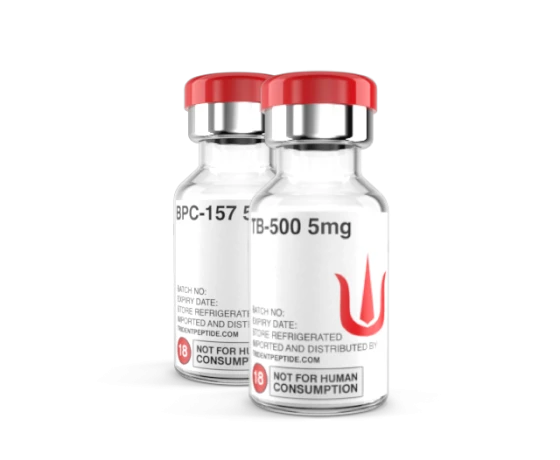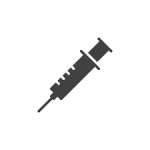BPC-157, TB-500 10mg (Blend)
$120.00
BPC-157
BPC-157 and TB-500 (Thymosin Beta-4) are peptides commonly studied for their potential in promoting tissue repair and healing. Both have distinct yet complementary mechanisms that, when combined, may offer synergistic benefits. BPC-157, a stable gastric pentadecapeptide, is derived from a protective protein found in the stomach lining. It has been shown in preclinical studies to accelerate healing of muscles, tendons, and ligaments by promoting angiogenesis (the formation of new blood vessels) and regulating the production of growth factors. Similarly, TB-500, a fragment of the naturally occurring Thymosin Beta-4 protein, plays a key role in cell migration, tissue regeneration, and reducing inflammation.
BPC 157, a pentadecapeptide derived from human gastric juice, has been demonstrated to promote the healing of different tissues, including skin, muscle, bone, ligament and tendon in many animal studies. However, the underlying mechanism has not been fully clarified. The present study aimed to explore the effect of BPC 157 on tendon fibroblasts isolated from Achilles tendon of male Sprague-Dawley rat. From the result of cDNA microarray analysis, growth hormone receptor was revealed as one of the most abundantly up-regulated genes in tendon fibroblasts by BPC 157. BPC 157 dose- and time-dependently increased the expression of growth hormone receptor in tendon fibroblasts at both the mRNA and protein levels as measured by RT/real-time PCR and Western blot, respectively. The addition of growth hormone to BPC 157-treated tendon fibroblasts dose- and time-dependently increased the cell proliferation as determined by MTT assay and PCNA expression by RT/real-time PCR. Janus kinase 2, the downstream signal pathway of growth hormone receptor, was activated time-dependently by stimulating the BPC 157-treated tendon fibroblasts with growth hormone. In conclusion, the BPC 157-induced increase of growth hormone receptor in tendon fibroblasts may potentiate the proliferation-promoting effect of growth hormone and contribute to the healing of tendon.
BPC-157 is typically administered via injection (subcutaneously or intramuscularly), but it is also occasionally available as a nasal spray or oral supplement, although the latter forms are less common.
Safety and Side Effects:
As of now, research on BPC-157 is primarily preclinical, meaning most data comes from animal studies. While there are anecdotal reports of its benefits and relatively few documented side effects, comprehensive clinical trials in humans are lacking, which raises questions about its long-term safety and efficacy. Potential side effects may include:
The legal status of BPC-157 varies by country. In many places, it is not approved for medical use and may be classified under different regulations. It is often available online as a research chemical.
Conclusion:
BPC-157 shows promise as a peptide that may aid in healing and tissue repair, but further research is necessary to establish its efficacy and safety in humans. Anyone considering the use of BPC-157 should consult with a healthcare professional in order to understand the risks and benefits, particularly given the lack of regulation and standardized dosing.
Does BPC-157 have a medical purpose?
Therapeutically, the synthetically produced peptide BPC-157 is not currently approved for use as a human drug. It is an experimental compound that has been investigated for inflammatory bowel disease and soft tissue healing, although there is a concerning lack of published clinical trial data because studies appear to have been cancelled or stopped without any published conclusions.
BPC-157
The potential synergy between these peptides arises from their overlapping yet distinct pathways in tissue repair. While BPC-157 excels at improving blood flow and reducing inflammation, TB-500 focuses on facilitating cellular migration to the injury site and supporting the repair process at the cellular level. Together, they may accelerate healing by addressing multiple aspects of tissue recovery, particularly in sports injuries or chronic conditions where regeneration is compromised. Early animal studies suggest this combination may lead to faster recovery times and improved structural integrity of repaired tissues.
It is crucial to note that while promising, much of the research on BPC-157 and TB-500 remains preclinical.


MAECENAS IACULIS
Vestibulum curae torquent diam diam commodo parturient penatibus nunc dui adipiscing convallis bulum parturient suspendisse parturient a.Parturient in parturient scelerisque nibh lectus quam a natoque adipiscing a vestibulum hendrerit et pharetra fames nunc natoque dui.
ADIPISCING CONVALLIS BULUM
- Vestibulum penatibus nunc dui adipiscing convallis bulum parturient suspendisse.
- Abitur parturient praesent lectus quam a natoque adipiscing a vestibulum hendre.
- Diam parturient dictumst parturient scelerisque nibh lectus.
Scelerisque adipiscing bibendum sem vestibulum et in a a a purus lectus faucibus lobortis tincidunt purus lectus nisl class eros.Condimentum a et ullamcorper dictumst mus et tristique elementum nam inceptos hac parturient scelerisque vestibulum amet elit ut volutpat.













Reviews
There are no reviews yet.